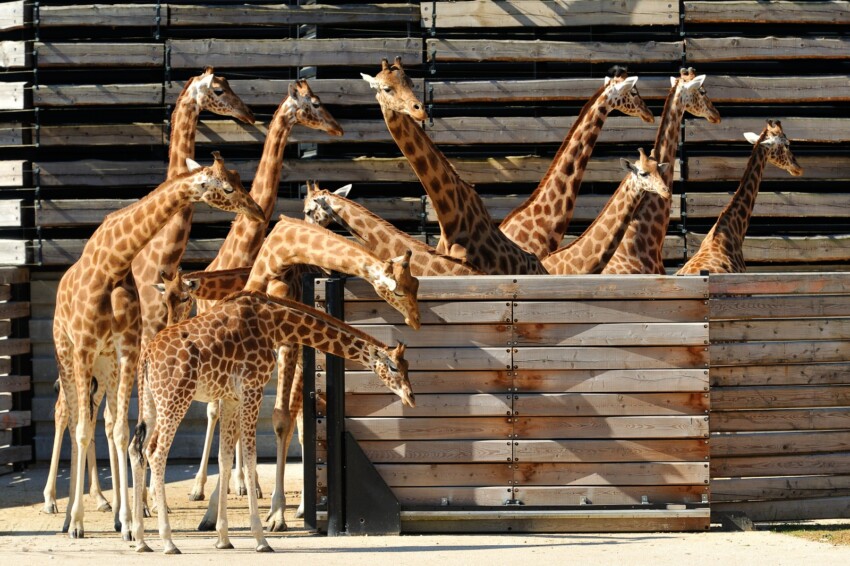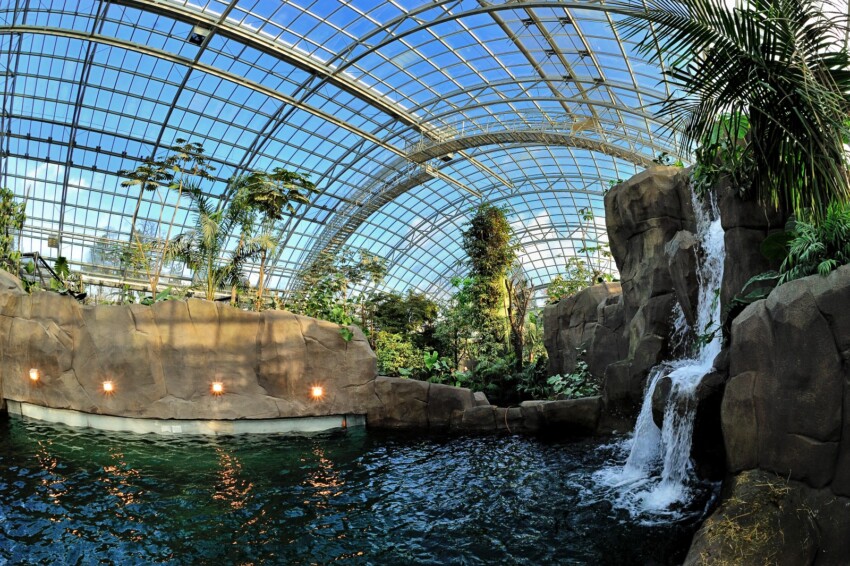
Far from the era when tigers and lions were kept as curiosities in microscopic cages, the new Paris Zoological Park, formerly known as the Vincennes Zoo, is designed to ensure animal welfare and the preservation of biodiversity.
Visitors feel immersed in the animals’ natural environments. The zoo’s 4-kilometre route crosses five biozones: the Sahel-Sudan savannah, the rocky coast and pampas of Patagonia, the large coniferous forests of Europe, the tropical climates of Guyana and the ecosystem of Madagascar. In total, the zoo is home to about 3,000 animals, of about 255 different species.
Alongside emblematic creatures such as giraffes, wolves, lions and white rhinoceroses, there are also lesser-known animals, including manatees and wolverines. In addition, an exceptional range of endangered species, from the Madagascar tree boa to the scimitar-horned oryx to the Grévy zebra, will take you on a tour of the world on the outskirts of Paris.

The presentation of animals in environments that evoke their original ecosystems, respect for their well-being and the visitor’s immersion have guided the architectural and landscape design of the Paris Zoological Park.
Mammals, birds, snakes, lizards, amphibians, fish and invertebrates: 255 species and more than 3,000 animals offer you a true world tour of animal biodiversity.
It comprises two ecosystems representative of the island: the tropical rainforest and the tropical dry forest. The tropical rainforest, located in the Grande Serre, is populated by colourful birds such as the grey-headed pigeon and the Madagascar pigeon, and by lemurs, including the most endangered, the greater bamboo lemur.
In a valley covered with sparse vegetation, the tropical dry forest consists of short plants, grasses and thorny shrubs and is home to the radiated tortoise and the crowned sifaka.
A monumental greenhouse immerses you in the tropical rainforest. Near a waterfall grow large ficus trees on which hang lianas and tropical plants. Small primates, white-faced saki and tamarins frolic in the branches.
Sloths and anteaters straddle the path, while numerous birds fly free in this lush environment. At the foot of the waterfall swim manatees, an emblematic Guyanese species that is unfortunately endangered, and giant bony fish such as arapaima and arowana.
Even if the ecosystems of Europe are more familiar to you than those of Africa or South America, the Paris Zoological Park invites you to take a fresh look at the European continent.
On either side of the Grand Rocher are the otter waterfall and the aviary of birds of prey, which is home to many endangered specimens such as the black vulture or the red kite.
Beneath the canopy of the tall black pines, beech, hornbeam, oak and birch trees create a forest atmosphere in which Iberian wolves, lynxes and gophers live, hiding among the trunks, drinking at the foot of the waterfall or perched on the rocks.
Inside the Grand Rocher, in the vivarium, terrariums recreating the marsh, scrub and mountain are populated by frogs, newts, toads, turtles, lizards and snakes. These European species, which are rare in zoological parks, such as the viper or the yellow-bellied toad, are thus distributed along a more than 200 m2 path.
With an area of 4.5 hectares, the African biozone is the largest in the park. It is home to large mammals such as white rhinoceroses, Grévy’s zebras and West African lions.
You will visit different environments, from wooded savannah to delta, through shrub savannah and across warmly coloured grasses, thorny shrubs and debris that recreate the atmosphere of this ecosystem.
The vast golden landscape of the African biozone is a backdrop for an entire herd of giraffes. The zoo’s emblematic residents, the 14 giraffes that remained in place after the zoo’s renovations, are the females Agamie, Aurore, Adeline, Ariane, Adège, Lady, Gaya, Goumie, Riwel and the young males Gatimu, Romy, Uzul, Roy Djuba.
In the continuity of the majestic volumes of the Grand Rocher hangs a large aviary of more than 2,000 m², which one crosses on a wooden jetty, amidst pink flamingos, white spoonbills, Abdim’s storks and hundreds of free-flying birds.
The Patagonia region, located in the southern part of South America, straddling Argentina and Chile, is home to a rich and varied biodiversity in its superb landscapes: the rocky coasts of the Andes Mountains and the vast desert plains of the steppes.
At the Parc Zoologique de Paris, Patagonia has been represented in a space of over 16,500 m² and presents 3 environments: the pampas, the rocky coasts and the Andean forest. The pampas or steppe of Patagonia, with its sparse vegetation and cool tones, is home to Darwin’s nandus, relatives of the ostrich, the maras or Patagonian hares and the guanacos, cousins of the llama.
Maned sea lions bask on rocks in the Patagonian biozone while Humboldt penguins roam back and forth in a nearby puddle. In addition to the bird’s-eye view of the basin, observe the underwater movements of the sea lions up close through the glass walls.
The evocation of the Andean forest is home to Andean pumas and pudus. Native to Chile, the Andean pudu is the smallest of the deer, its size of 40 centimetres allowing it to sneak through the vegetation of the dense forests.
The zoo is open every day, including public holidays, except for the annual closure in January. The Paris Zoological Park’s opening hours change according to the seasons.
Winter hours: from Monday of the third week in October to the last Sunday in March inclusive, every day from 10 a.m. to 5 p.m. Annual closure after the Christmas holidays for 3 consecutive weeks, including weekends.
Summer timetable: 21 June to 31 August, daily from 09.30 to 20.30 with night openings every Thursday from mid-June to mid-August from 19.00 to 23.30.
Interseasonal hours: from the last Monday in March to 20 June and from 1 September to the second Sunday in October inclusive, open from 09.30 to 18.00 on weekdays and from 09.30 to 19.30 on weekends, public holidays and school holidays.
The Parc Zoologique de Paris is located at the intersection of Avenue Daumesnil and Lake Daumesnil, in the 12th arrondissement. It can be reached using several metro lines: line 8, station Porte Dorée and a 7-minute walk from the zoo entrance, line 1, station Château de Vincennes, then bus 46.
Alternatively, you can use buses: lines 46, 86, 201 and 325, stop Mezzaluna – Parc Zoologique, line 77, stop Porte de Charenton or trams, line T3, stop Porte Dorée and then a 7-minute walk to the zoo entrance.
City Card allow you to save on public transport and / or on the entrances to the main tourist attractions.
